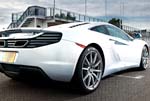Britain’s new supercar reviewed: McLaren MP4-12C
Lord March reviews Britain’s new super car: the McLaren MP4-12C.


As a boy, I can vividly remember the sound of Denny Hulme driving around the Goodwood track testing his McLaren. The memories linger, and, all these years later, the connections between Goodwood and one of the world's most established and successful motor-racing companies continues and grows stronger.
We have been lucky enough to have a regular stream of McLaren cars making rapid progress up the hill climb during the Goodwood Festival of Speed each summer. In fact, the record for the hill climb was set in 1999 by Nick Heidfeld in a McLaren MP. So, with this shared passion for speed, I was delighted when McLaren chose the 2010 festival for the global launch of the McLaren MP4-12C, with both current Formula 1 McLaren drivers Lewis Hamilton and Jenson Button spurring the car up the Goodwood hill climb in front of 176,000 admiring fans.
I was thrilled to have the opportunity to drive a beautiful early production MP4-12C at a special track day at Goodwood. This is my opportunity to invite special guests to drive some wonderful cars on the old track and to mingle with some well-known faces, including Derek Bell, Jonathan Palmer and Anthony Hamilton (Lewis' father). At first sight, the new McLaren is striking, but in a totally practical way, as it has no extraneous frippery and flash. It has a no-nonsense, business-like look. I first slipped into the passenger seat beside McLaren Automotive test driver Chris Goodwin. Chris has raced in the British and FIA GT Championships and has been instrumental in the development of the MP4-12C.
After a couple of laps and a run through the controls, it was my turn to drive, and, immediately, it was clear that the new McLaren really is an extraordinary car. Although it bristles with electronics, the feel from behind the steering wheel is of a very mech-anical process, giving wonderful feedback to the driver and razor-sharp reactions.
The steering-wheel-mounted gearshift paddles work in exactly the same way and with the same gear-change pressure and precision as in a Formula 1 car. Particularly impressive is the way the car handles corners. Another of the Formula 1 technology systems that's used on the new McLaren road car is the ‘brake steer' system, which was developed for David Coulthard's 1997 Formula 1 car, but eventually outlawed by the FIA. Without any intervention from the driver, the car slightly applies the brake on the inside wheel at a corner, pulling itself in and making it easier to hit a tight apex.
These electronic systems control the car wonderfully without taking away any of the thrill of driving. In every way, the MP4 is incredibly quick to react and although I know there are electronic systems monitoring my every move, the technology is totally invisible and, as a driver, I felt completely in control of the car at all times.
One of the measures of the joy of driving this car comes from my friends at McLaren, who tell me that they find it very difficult to get Lewis and Jenson out of the development cars. And after he had driven a couple of laps, Anthony Hamilton told me that the MP4-12C made him feel he could drive just like Lewis. I experimented with the adaptive damping and hydraulic roll control settings, adjusting the settings between sports and track. I could feel myself getting rapidly quicker on each successive lap.
Sign up for the Country Life Newsletter
Exquisite houses, the beauty of Nature, and how to get the most from your life, straight to your inbox.
However, this is no uncompromising track car. In normal setting, it becomes a comfortable grand tourer. It's not the sort of car where I would set off for London and have been bumped out of my seat by the time I reached Guildford. It's been developed using the McLaren Formula 1 team's sophisticated simulators and has been subjected to a rigorous testing schedule with more than a million miles covered in testing. It's clear that every single aspect of the new car lives up to the incredibly high standards that McLaren sets itself in Formula 1.
To produce the new car, McLaren has invested £40 million in a new production centre at Woking, which is closely linked to the F1 development centre to ensure a continual flow of information from the Formula 1-bred systems to the McLaren Automotive team and its road cars.
The company pioneered the use of carbon fibre in Formula 1 30 years ago, and the McLaren F1 was the first production road car to use a carbon-fibre chassis. Then, it took 3,000 hours to produce each chassis, but now, with 30 years' carbon-fibre manufacturing experience and an investment in robotic manufacturing, the MP4-12C chassis can be produced in just four hours. By the middle of this decade, the company's road-car production will rise to a capacity of 4,000 carbon-fibre-based cars each year.
There is no doubt in my mind that this is a true supercar. The attention to detail in development, testing and building the new MP4-12C, plus McLaren's philosophy of absolutely no compromise have produced a car that will set things on a whole new level. If I was asked to define McLaren, I would say its values are technology and performance. That doesn't just mean controlled speed it means being totally focused and taking no shortcuts in the pursuit of excellence.
I've heard McLaren personnel refer to this as a ‘conquest vehicle' designed to be the best car in its sector. With true supercar performance and at a competitive price, I believe the MP4-12C is going to thrill drivers all over the world. Once again, it makes you very proud to be British.
The Goodwood Festival of Speed, West Sussex, runs from June 30 to July 3 (www.goodwood.co.uk/festival-of-speed)
* Subscribe to Country Life and save 40%
Country Life is unlike any other magazine: the only glossy weekly on the newsstand and the only magazine that has been guest-edited by HRH The King not once, but twice. It is a celebration of modern rural life and all its diverse joys and pleasures — that was first published in Queen Victoria's Diamond Jubilee year. Our eclectic mixture of witty and informative content — from the most up-to-date property news and commentary and a coveted glimpse inside some of the UK's best houses and gardens, to gardening, the arts and interior design, written by experts in their field — still cannot be found in print or online, anywhere else.
-
 The big reveal: A first look at Country Life's RHS Chelsea Flower Show stand
The big reveal: A first look at Country Life's RHS Chelsea Flower Show standInterior designer Isabella Worsley reveals her plans for Country Life’s ‘outdoor drawing room’ at this year’s RHS Chelsea Flower Show.
By Country Life
-
 Schreiber House, 'the most significant London townhouse of the second half of the 20th century', is up for sale
Schreiber House, 'the most significant London townhouse of the second half of the 20th century', is up for saleThe five-bedroom Modernist masterpiece sits on the edge of Hampstead Heath.
By Lotte Brundle